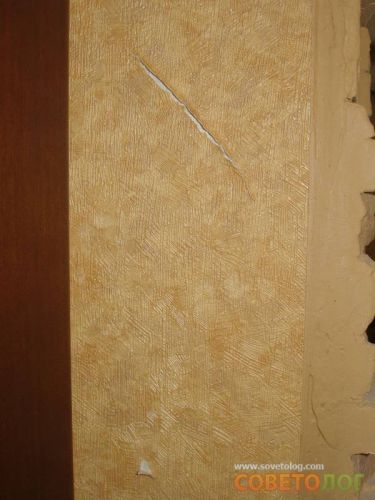If the wallpaper peeled off how to glue them. Special wallpaper compositions. Wallpaper sticker rules
How nice when the apartment is renovated and everything is replete with novelty. Everything is done as you wanted and you are proud of the work done. However, after a few days you find that your wallpaper has peeled off! One corner fell off, then a joint, and so on... The room, which was recently the embodiment of your hopes and aspirations, has turned into a room with swollen wallpaper that spoils the whole view.
At this point, the first questions arise: “why does the wallpaper peel off”? What to do if the wallpaper peeled off? Let's take a look at all these questions in this article in order.
Reasons for peeling wallpaper
Incorrect surface preparation
This is the very first thing to analyze. The base for pasting could be poorly prepared. You may not have controlled the deletion enough. old plaster, chalk or putty. You can say that you used a primer, for a better connection. However, if you have not carefully removed the remains of the plaster, it turns out that the wallpaper is glued to this surface, which, after drying, sooner or later will disappear.
So back to the start construction process, the surface should be well prepared for wallpapering. If the surface needs fresh plaster, make up for this deficiency. Be sure to apply the primer, but do not rush, allow enough time for it to soak in and dry.
Holes and cracks in the walls can also cause marriage. These defects are the result of mistakes made during the construction of the walls. It is worth noting that they are not so easy to eliminate. In this case, the best thing that can be done is to use drywall boards. They are able to quickly level the surface of the walls, do not require special skills and forces. There are many sites on the Internet that provide comprehensive information about working with drywall, so you can build a new wall on your own.
The quality of building materials
Even if you have properly prepared the surface, primed and waited between all the stages, the problem may be in the poor quality of the materials. Glue, primer, mortars and other building materials are best bought in specialized stores. It is in their interests to monitor the quality of products and observe proper storage conditions. Some dry mixes, having spent the winter in the cold, lose their properties and cannot be reliable.
Also, when buying, pay attention to the expiration date and do not settle for low price expired products. Choose materials from trusted manufacturers, usually such brands are well-known and widely known. Buy quality material, do not save. Then you will be sure of the reliability of the repair, and the wallpaper will not dare to peel off.
Violation of the rules or order of work
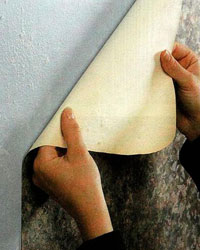 It would seem that they did everything: prepared the basis for pasting, chose best materials but the wallpaper is still peeling off. What is the reason? We answer. Insufficient time allowed for the final drying of the prepared surface. Any plaster: basic or finishing, as well as a primer, must dry completely before pasting the wallpaper. If you did not withstand the time interval, the wallpaper canvas will fall behind at the junctions.
It would seem that they did everything: prepared the basis for pasting, chose best materials but the wallpaper is still peeling off. What is the reason? We answer. Insufficient time allowed for the final drying of the prepared surface. Any plaster: basic or finishing, as well as a primer, must dry completely before pasting the wallpaper. If you did not withstand the time interval, the wallpaper canvas will fall behind at the junctions.
Among other things, remember, you may not have fully followed the instructions that came with the wallpaper or glue. Most often, glue is applied to the surface of the wallpaper for their complete impregnation, only after that the wallpaper is placed on the wall treated with glue. Modern wallpaper may stick more simple ways One way or another, all wallpaper manufacturers indicate the order of work on the labels.
Just follow the instructions, and if you have any questions, you can ask them to the employee of the store where you made the purchase. To create high-quality joints, it is often recommended to use paper tape. It can be completed with wallpaper, you can also buy it yourself.
Speed up the drying process
If you have provided all the points described above, but wanted to see the updated room as soon as possible by opening the doors or windows for ventilation, let's face it - you yourself helped the wallpaper peel off. Air currents can interfere with the establishment of interatomic bonds between the wallpaper and the wall. The drying process of the glue - do not speed up. You may notice that the wallpaper peels off just behind the batteries, in case of repairs in the winter.
So, we figured out why your wallpaper spoiled your mood.
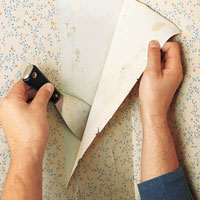 The question remains: what can be done in this case? It makes no sense to tear everything off completely, if you need to restore it, only separate plot. It's easier to glue them back. But easier said than done. The wallpaper canvas may contain pieces of plaster, due to which the glue cannot securely fix the area. In this case, feel free to remove excess residue, nothing will happen to the wallpaper. Carefully wash off everything unnecessary from the wallpaper, let it dry and glue it on PVA glue.
The question remains: what can be done in this case? It makes no sense to tear everything off completely, if you need to restore it, only separate plot. It's easier to glue them back. But easier said than done. The wallpaper canvas may contain pieces of plaster, due to which the glue cannot securely fix the area. In this case, feel free to remove excess residue, nothing will happen to the wallpaper. Carefully wash off everything unnecessary from the wallpaper, let it dry and glue it on PVA glue.
At the same time, wait until the glue is absorbed into the surface of the wallpaper, also pre-anoint the wall with glue. In addition to the PVA glue known to everyone since childhood, in the store you should pay attention to such brands as Moment, Kleo or MV-50. Take glue in tubes, so you can apply it conveniently, and save the rest for other household purposes. So you will cope with the problem of wallpaper peeling, eliminate all inconveniences and return peace of mind. We wish you a successful renovation!
Help for a beginner
Those who glue wallpaper for the first time in their life often encounter the fact that after gluing the wallpaper adhered well to the base, but they do not look as beautiful as they would like. For example, the surface may be bumpy or even have noticeable pits. Of course for textured wallpaper it’s not scary at all, because it’s imperceptible, but here are expensive fabric products or just natural wallpaper need a flat and smooth base.
In order to avoid the formation of bumps and other troubles that may be noticeable on the surface of the wallpaper layer, it is necessary to initially process the wall sandpaper, remove all soapy chips and other irregularities. Then primed with simple wallpaper paste, although a quality primer is recommended.
 Also remember that you can not glue wallpaper on damp, especially wet walls this is the first reason why wallpaper peels off, as it does not absorb glue well.
Also remember that you can not glue wallpaper on damp, especially wet walls this is the first reason why wallpaper peels off, as it does not absorb glue well.
You can check the wall for moisture at home in the following way: in the evening plastic bag it must be attached with adhesive tape to the wall, and in the morning you should check if moisture has formed on it. In the event that the humidity is high, then it is necessary to dry the wall well. For this, ventilation is used, both simply natural and accelerating artificial.
Having all the knowledge of why the wallpaper peels off the walls, we can say that we are protected from problems that may arise both during the repair and after it. Now wallpapering any room will end with luck, and the result at the end of the repair will please the household for a long time.
Regardless of the type of wallpaper, they sometimes peel off the wall. This can happen the next day after wallpapering, or maybe a few years later. We will talk about all the reasons why the wallpaper lags behind the wall and what to do about it in this article. And I will also tell you how to glue peeling wallpaper.
Improper drying.
Wallpaper must not only be properly glued to the wall, but also properly dried. To do this, drafts should not be created in the room for 2-3 days after wallpapering, air conditioners, heating systems, etc. should not be turned on. Since this will provoke uneven and rapid drying of the wallpaper. The wallpaper during this time should get wet and, as it were, merge into one with the wall.
Also, if you have a heating battery running while wallpapering, then 100% of the wallpaper will fall behind it. Therefore, during wallpapering and after that, the battery must be disconnected for 2-3 days.
To increase the drying process, and this is important on hot summer days, several buckets of water are brought into the room. Thus, the humidity will increase there, which will not allow the wallpaper to dry quickly.
The wallpaper peeled off after a few years.
If the wallpaper served in you for a long period of time, and then suddenly it began to peel off, this means that the wall, for some reason, began to dampen. Perhaps pipes are leaking in the wall, or the roof is in disrepair and stormwater is running down the wall. In this case, it is necessary to remove the cause of the dampness of the walls, then dry them and then glue the wallpaper back to the wall.
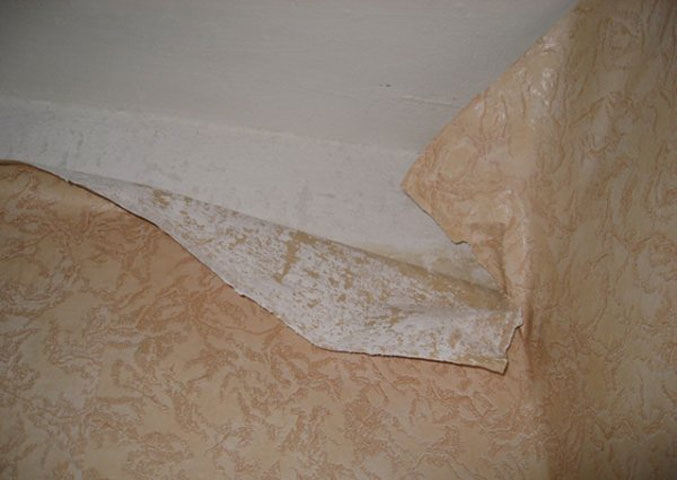
And if during all these years the wallpaper has peeled off a little in you, it may be a combination of all reasons. But in most cases, this is the use of low-quality glue. I often observe this when wallpaper is glued onto a paste prepared with my own hands. Do not do this, it is better to buy glue from trusted brands and glue the wallpaper with it.
Why do wallpaper peel off at the joints. Video
How to glue peeled wallpaper.
If the wallpaper is peeled off and partially torn off the wall, whitewash, paint or putty, then they must be cleaned warm water. Do this carefully so as not to damage the canvas. If there is nothing on the canvas, immediately proceed to gluing them.
To do this, apply glue with a brush on the wallpaper, which has peeled off and on the wall. The canvas should soften for 1-2 minutes, after which proceed to smoothing with a wallpaper spatula. When applying glue, do not spare it. Better to have the glue come out of the seam than not enough.
Glue for gluing is used the same as for gluing wallpaper. Therefore, after gluing the wallpaper, you need to leave the glue. When cooked, it can stand relatively long time. As practice shows, most often the wallpaper peels off the next day or every other day. During this time, nothing will happen to the prepared glue.
If the wallpaper peeled off in you after a few months or years and there is no wallpaper paste left in you, with which you glued the wallpaper, do not rush to buy a new pack. You do not use it completely, but it is better to glue it with PVA glue. This glue can be glued to all types of wallpaper.
In order for you to clearly see that there is nothing heavy in gluing, I will give you this video.
If, after you have pasted the wallpaper, they peel off, then the reasons can be either glue for other wallpapers, poorly greased wallpaper sheets or a wall with glue, or a poorly prepared wall surface.
But in this case, you should not worry, these oversights can be corrected.
How can I paste wallpaper
We’ll make a reservation right away that it’s not worth gluing the wallpaper with PVA glue, because in a few months they will be replaced by yellow spots, and if you re-paste the wallpaper, then the old wallpaper will not peel off well from the wall surface.
Now what we need to paste the wallpaper:
- Glue that is suitable for pasting this type of wallpaper.
- Spatula, brush.
- Brush.
- Soft cloth.
- Rubber roller.
- Other handy tools.
How to glue old wallpaper
We proceed to gluing: the wallpaper that has lagged behind the walls is slightly taken away from the wall with a spatula and we clean the surface with a brush from dust and other debris. With a brush dipped in the adhesive composition, we coat the entire surface of the wall above the raised wallpaper. See that there is not a lot of excess glue on the brush - it needs quite a bit, only to coat the surface thin layer. After that, we press the wallpaper against the wall, remove excess glue with a rag and press it with a roller until it is completely glued.
Do not forget to also follow a few rules when gluing and wallpapering.
- The temperature in the room where you glue the wallpaper should be between 18 and 25 degrees.
- Do not open the windows, otherwise all the wallpaper will peel off.
No need to paste wallpaper
- If you want the wallpaper not to lie on the floor the next day after pasting, learn the rule - you need to thoroughly clean the walls of old wallpaper and apply a primer to the walls.
- The quality of wallpaper pasting depends on the right glue, you need to choose the glue that is indicated on the packaging of the wallpaper and also pay attention to the expiration date. You also need to prepare the glue according to the instructions indicated on the package.
- Correctly apply glue to the wallpaper: pay special attention to the edges of the wallpaper, because the joints must be well coated. Do not try to speed up the drying of the wallpaper with fans and heaters.
- Poor quality glue or other materials may be the reason for peeling off the wallpaper, so it’s better to buy quality materials. The primer must not be stored in cool rooms, because after contact with cold, the primer becomes unusable.
- Ask a salesperson for some wallpapering tips - maybe they can help you.
Well, when gluing wallpaper at the joints, you can use special glue in tubes, it does not leave stains and glues well.
The apartment has been renovated. But it often happens that in some places the wallpaper, and more often the joints of the wallpaper, can peel off. Or maybe you did not carefully bring the furniture and ripped off a piece of wallpaper, or your pets messed up the walls. You shouldn't get upset. The integrity of the wallpaper can be tried reestablish. The better to glue and how to restore the wallpaper, we will tell in this material.
For this we need:
- good thick PVA glue,
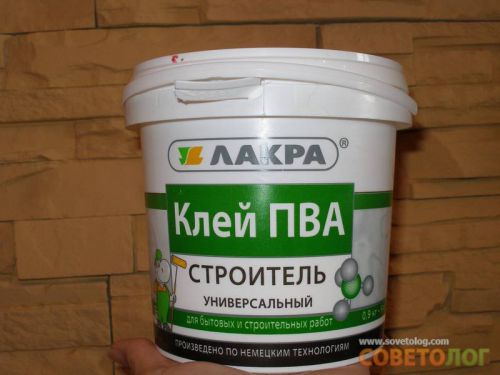
- small brush
- ordinary household hair dryer with hot air mode
- a clean, damp cloth.
Let's start with the simplest...
How to glue wallpaper joints and small pieces
The reasons for the divergence of wallpaper seams can be some. Perhaps the wall was poorly primed, or the putty was not very good. good quality. Maybe during the wallpapering, the window was ajar, or the edge was simply badly smeared with glue.
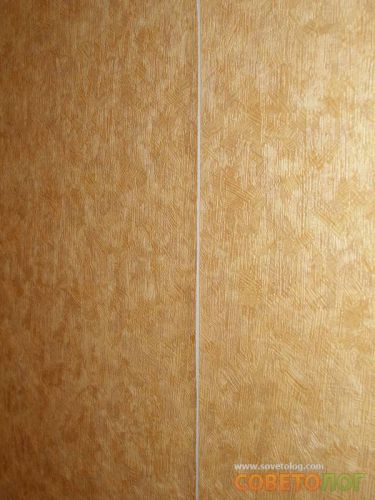

To correct the situation, try as carefully as possible. turn away torn seams. If pieces of putty from the walls remain on the wallpaper, then they must be carefully delete, after which the wall and wallpaper carefully vacuum so that pieces of debris do not fall under the wallpaper, otherwise on the wallpaper there will be bumps. If the layer of loose putty is thick and large in size, then the wall must first to putty, to prime and let dry. Otherwise, the outline of the piece that has fallen off will also appear on the wallpaper.
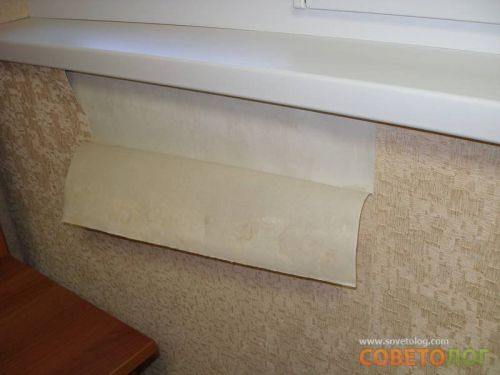

If wallpaper paper, then we work dry rag. But more often such a problem as a divergence of joints occurs precisely with heavy vinyl wallpaper (silk-screen printing). Such wallpapers are best smoothed wet with a rag, expelling all the bubbles from the glued part to the edge.
If the glue protrudes from the seams, wipe it with the same rag. Rinse the cloth well in cold water.
Vinyl wallpaper with a damp cloth not terrible.
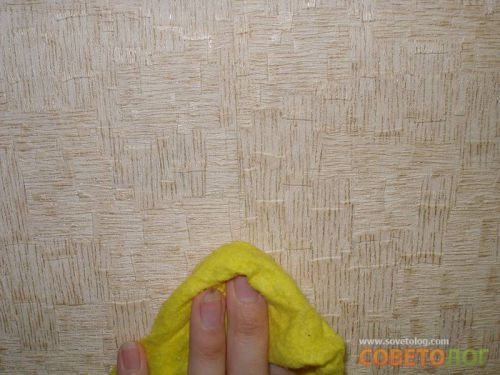
We warm up the seams hair dryer in hot blow mode. And once again we go through the seams with a rag, pressing the wallpaper well. The whole secret is that PVA glue at elevated temperatures polymerizes and fast seizes.
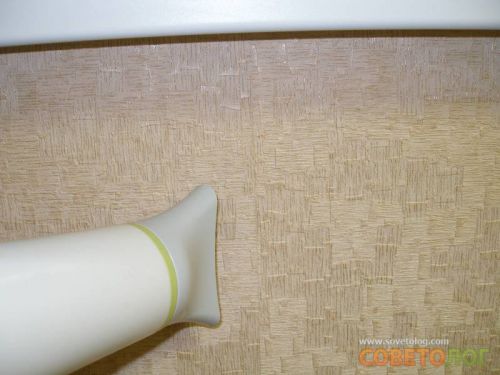
You can, of course, iron to iron through dry rag, but, firstly, if the glue comes out at the seams, then the rag can stick and ruin appearance wallpaper. Secondly, you can not guess with the temperature and spoil upper layer wallpaper.
How to seal minor tears and scratches
Scratches and scuffs are glued in a similar way. It is important that all the pieces are in place.
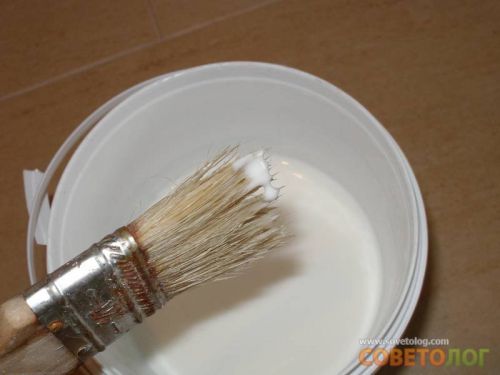
Good we smear scratch, gently bending the edges. If the scratch is small, then glue can be used toothpick.
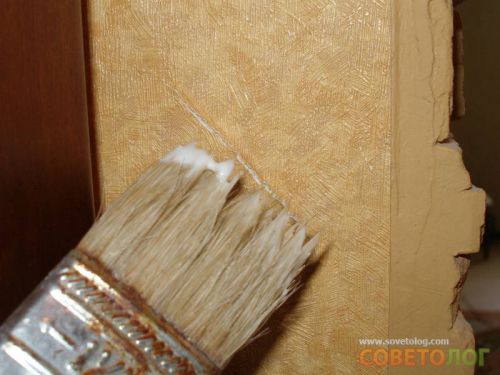
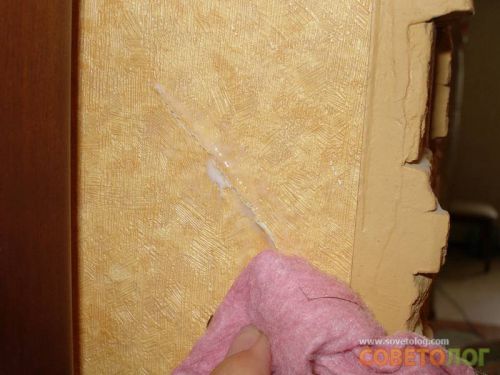
The edges of the scratch have stuck, but the scratch itself is still noticeable.
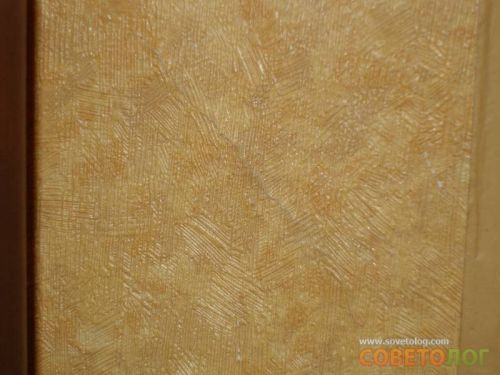
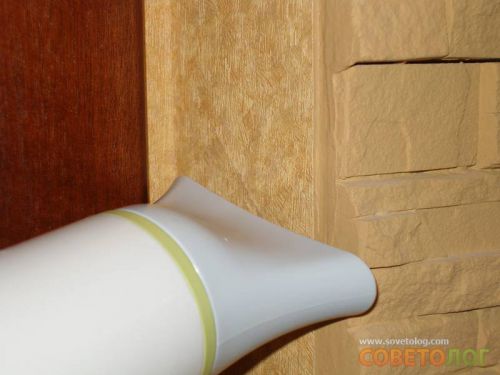
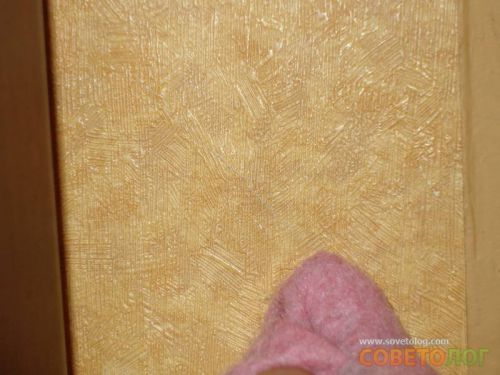
And, oh miracle! The scratch has disappeared.
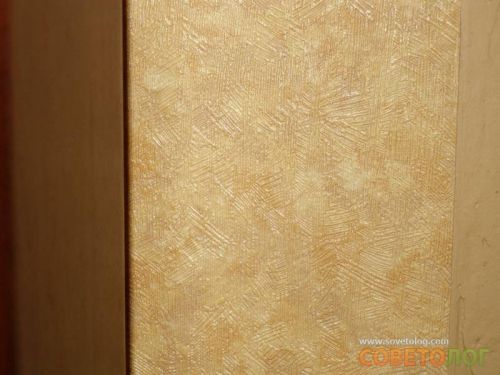
In this way, even very damaged wallpapers can be restored. The main thing is that all the pieces, even if they are torn off, are available.
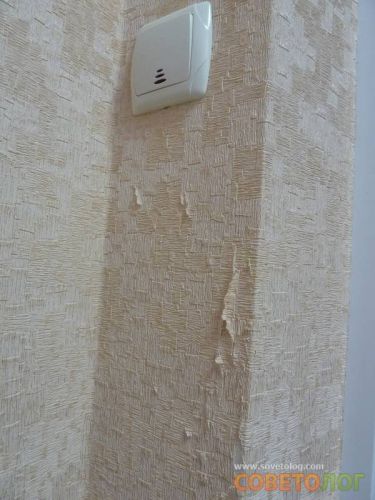
Each scratch is glued separately, as shown above. Pieces of wallpaper torn off completely return to their places. If the work is done carefully and diligently, then you will not notice even traces of former damage.
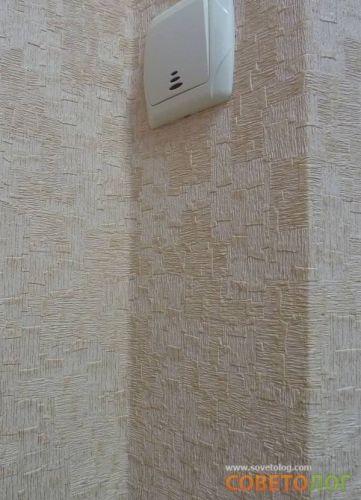
If your pets like to tear up their wallpaper, you should also create the necessary conditions. Damaged wallpaper must be glued straightaway, and do not reap until the corner is covered in tatters, and the torn pieces are lost.
Replacing the damaged part of the wallpaper
Replacing the damaged part of the wallpaper completely, so that it is not noticeable, is not so easy. If it is no longer possible to glue the wallpaper (the torn fragments are lost, they are torn to shreds) or they are completely damaged, for example, by children's drawings, then you can cut out the damaged part and paste a new one. Therefore, after the repair, do not throw away the remnants of the wallpaper. Leave on possible repair at least half a roll.
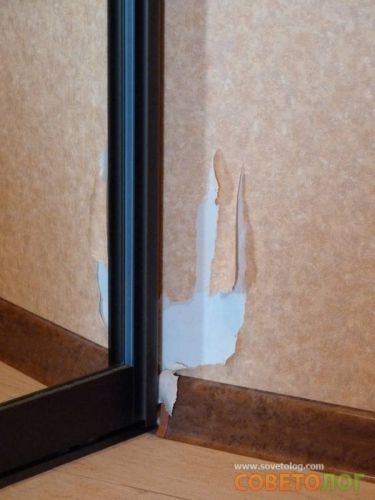
If the damaged area is close to the floor, it is easier to replace the entire piece down to the floor. Before replacing, remove the plinth.
Cut out the old wallpaper with a paint knife. Remove the damaged area from the wall. If the wallpaper is poorly removed, then you can moisten or sprinkle them with water. We cover with a margin (at least 5 cm) on all sides the damaged area with new wallpaper, if there is a pattern, then we combine it. Mark the length of the wallpaper along the bottom edge.
We fold the wallpaper and cut it with a knife according to the markup.
We coat the wall and the bottom of the wallpaper with glue. Wallpaper at the docking point must be dry, otherwise it will be difficult to cut them.
We start gluing the wallpaper from the bottom. Align the pattern, smooth it out, expel the bubbles. In places of docking, the wallpaper is overlapped. With a paint knife, we cut through both layers of wallpaper with one cut (at one time), if you succeed, then it is desirable to make the cut line wavy.
Removing the bottom edge of the wallpaper.
Glue the rest. The edges of the wallpaper must be glued end to end.
If everything is done correctly, then you will not notice the seam.
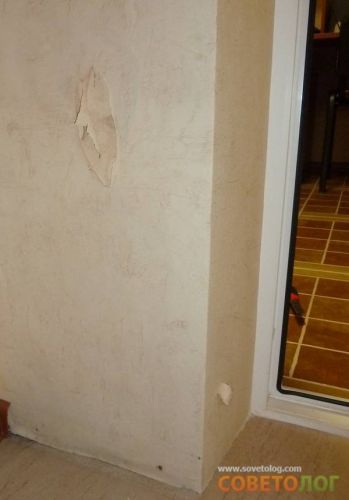
![]()
If you pick up the pieces no possibility, and there is no extra wallpaper, then you can try to combine the wallpaper, or decorate the corners with wooden slats, artificial stone. You can cut out “bricks” from drywall, coat them with plaster for texture and paint water-based paint under stone or under brick.
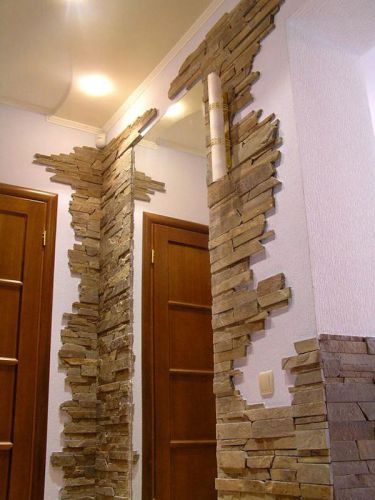
Material author:
Repost
Sometimes there are times when the wallpaper peels off the walls. This can happen for completely different reasons. In this article we will tell you how to glue the lagged canvas, what can be used for this, and how to do it correctly.
Reasons for peeling wallpaper
Basically, if the wallpaper moves away from the wall, it means that the surface was poorly prepared. After all, many people forget that the wall must be puttied and treated with a primer, otherwise the result can be very deplorable. It can also be affected by improperly selected glue, which may be of poor quality, so be sure to check the expiration date before buying. Let's take a closer look at the causes of peeling:
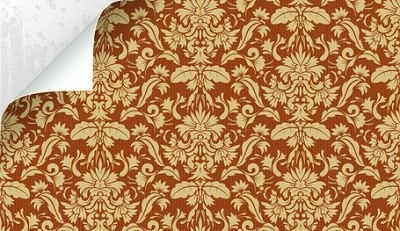
How to glue peeled off wallpaper
What tools are suitable
If you notice that the wallpaper has peeled off, try to glue it as soon as possible. For gluing you will need:
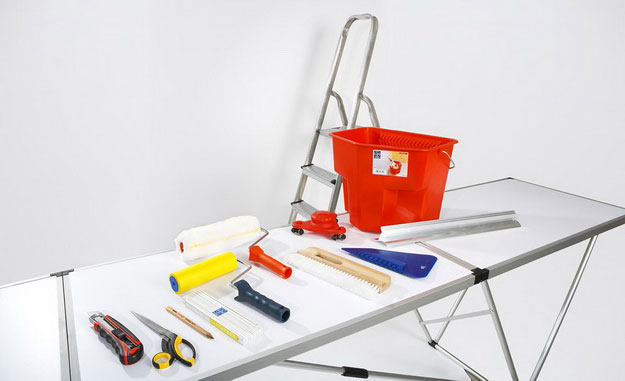
We glue the joints
If the wallpaper has come apart at the seams, don't worry, it's easy to fix. It is necessary to carefully move the edge of the canvas with a spatula and remove debris. Next, apply wallpaper paste along the joint and press the edge with a rubber roller. Remove the rest with a dry cloth.
If the canvas has moved away from the wall near the floor or ceiling, then take wallpaper glue. It must first be diluted with water and only then the canvas should be well lubricated. Wait about five minutes and then gently reattach the peeled off strip. Remember that the joints must be carefully treated with glue, as they play big role in wallpapering.
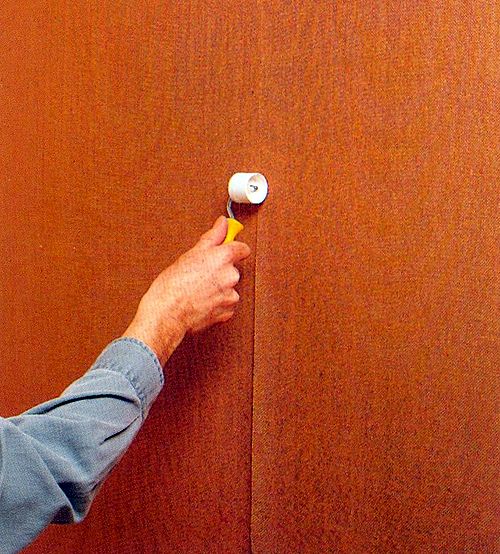
Pasting wallpaper after a cat
In case your animal likes to peel off the coating, we advise you to use more durable non-woven wallpaper or even use paint for decoration.
If the cat messed up not large plot wallpaper, it can always be glued or re-glued. To do this, measure the damaged area that will have to be redone, and cut off the necessary part from the roll. Then remove the damaged coating from the wall and glue the prepared piece again.
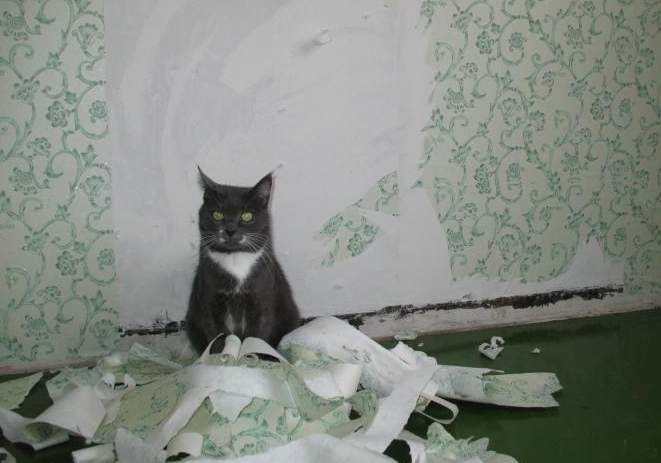
How to re-glue a large area
If a large area or a whole strip has peeled off, proceed as follows:
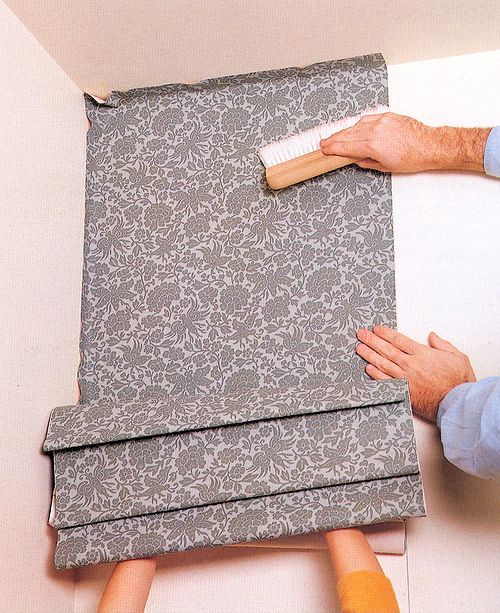
Bonding non-woven fabrics
A common reason for peeling non-woven material is non-compliance with the rules of gluing. An instruction is always attached to the product, which says how you can and should glue such wallpapers, so always read it. Remember that when gluing such a coating, only walls should be treated with glue, the wallpaper itself is not smeared with glue.
To glue such material, you can use glue and a spatula. Apply glue to the joints and the wall and let it soak in, wait about ten minutes. For better adhesion, it is recommended to roll over the surface with a roller.
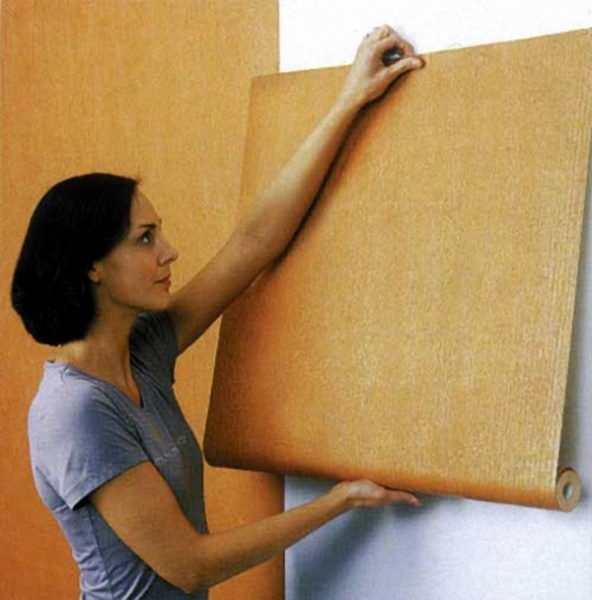
Can PVA glue be used?
Although PVA glue is very popular, its use for gluing wallpaper is undesirable. PVA after drying is very poorly soluble in water and therefore it will be extremely difficult to remove the coating before the next repair. Also, due to such a solution, yellow spots may appear. AT construction stores you can buy special PVA wallpaper glue, less concentrated than its universal counterpart, which does not leave unwanted stains, but it is not suitable for large pieces wallpaper, as it does not prevent the canvas from slipping. It can be used for gluing corners, however, if the walls are not made of drywall. PVA glue and GKL are incompatible things.
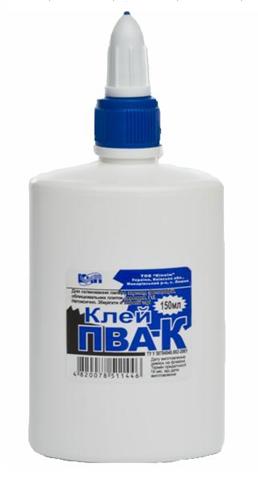
How to glue wallpaper without glue
We recommend not to experiment, but still buy a special glue. As we have already seen, PVA is not suitable for gluing. Many advise using flour to restore small areas, first diluting it with warm water. But we would not advise taking risks, because such a solution can only worsen the problem.
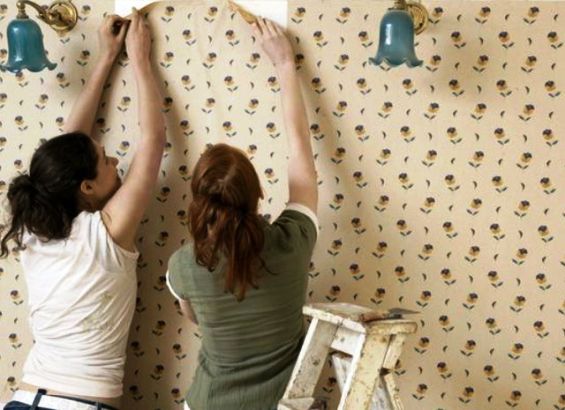
Drawing conclusions, we can say that you should not panic if your wallpaper has peeled off. The main thing is to try to identify and immediately fix the problem by applying special glue. Folk methods and PVA is better not to use, as you risk ruining the surface and the repair will have to be redone. Watch the following video, which shows in practice how to properly glue peeled wallpapers and joints:

